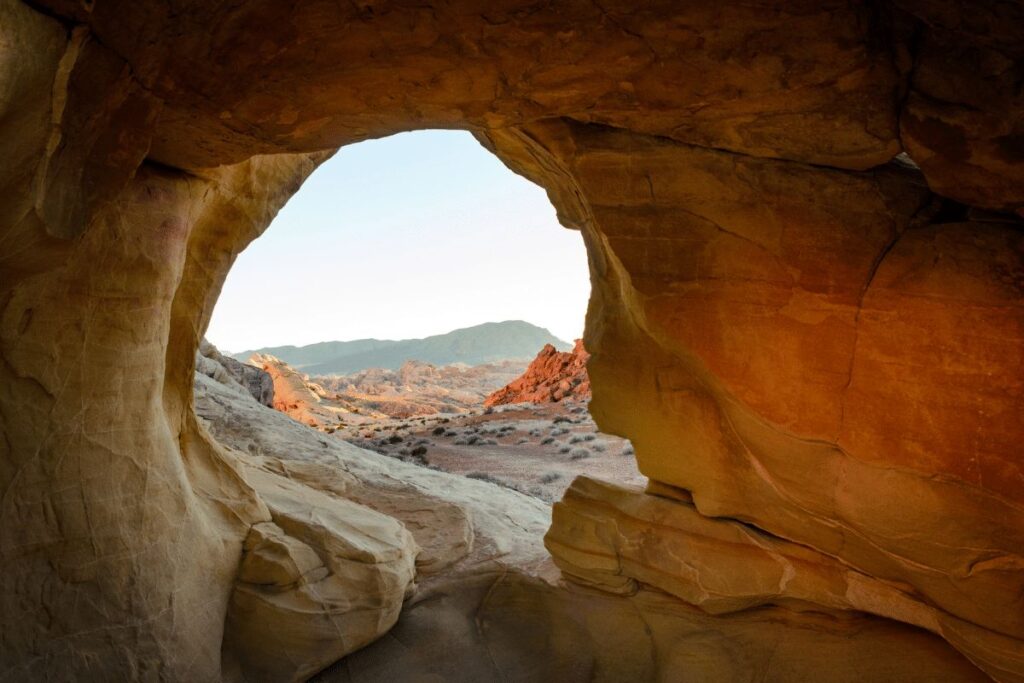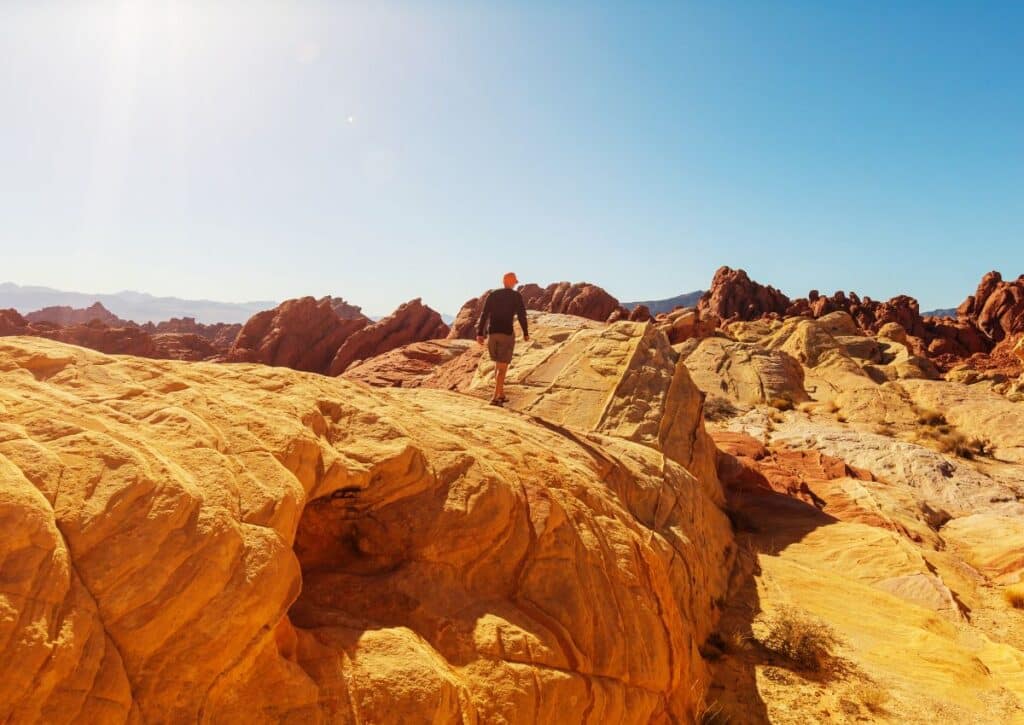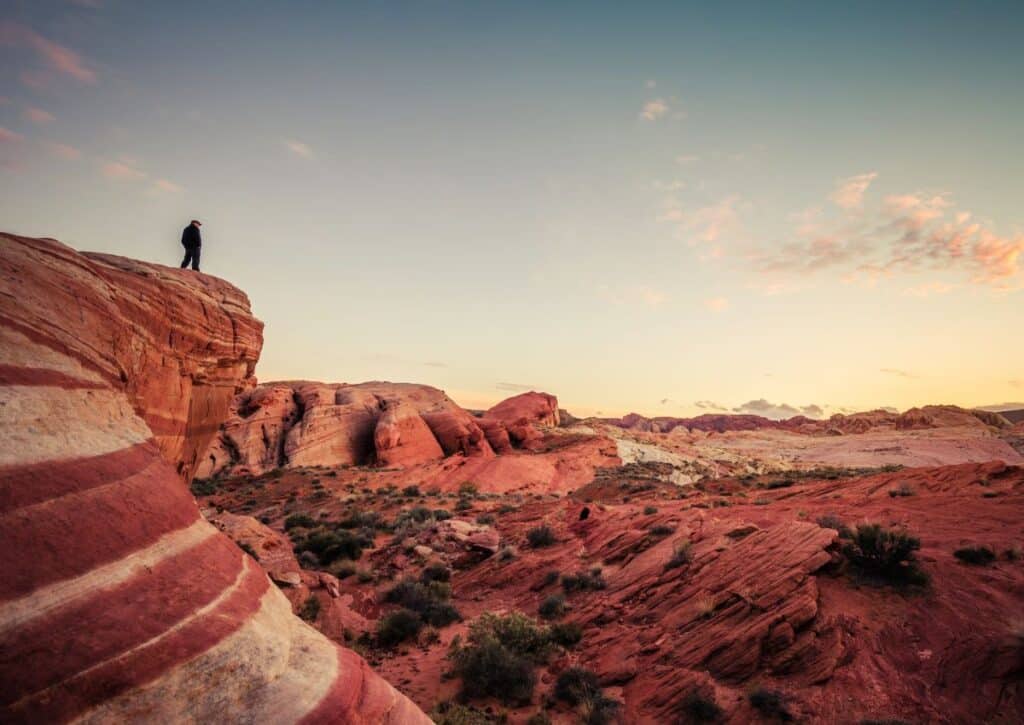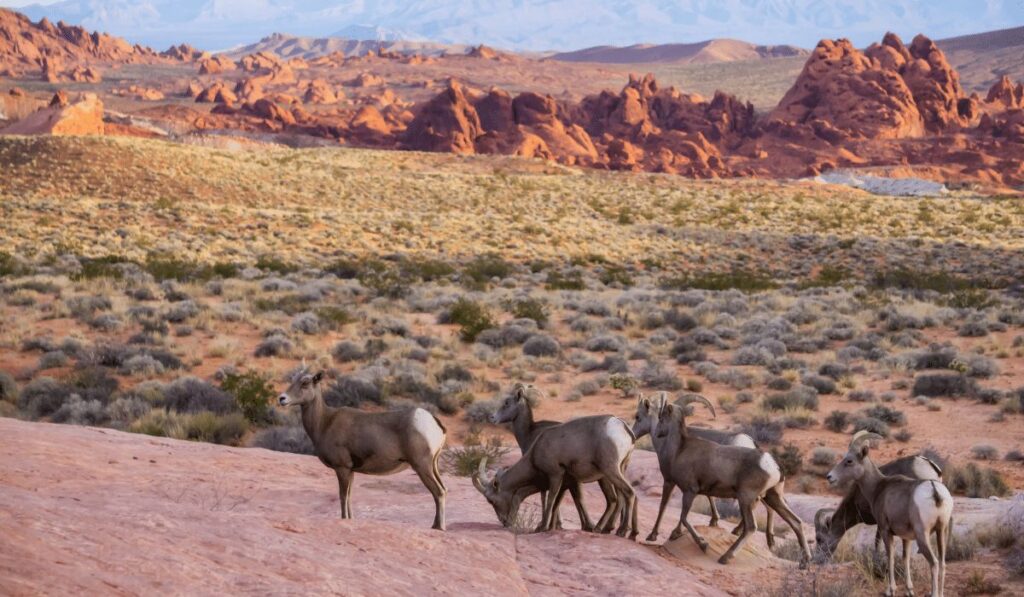Get ready for a visual feast as we delve into the 11 must-see vistas of Valley of Fire State Park, a stunning natural playground just an hour from Las Vegas.
From the intricate petroglyphs at Atlatl Rock to the mesmerizing colors of the Fire Wave, we’re unveiling the park’s best-kept secrets and breathtaking landscapes.
Imagine strolling through vibrant canyons, marveling at unique rock formations, and spotting local wildlife along the way.
In this article, we’re sharing our personal journey through the park, highlighting each spectacular vista and the trails that lead you there. So grab your hiking boots and a sense of adventure; an unforgettable exploration of Valley of Fire’s most iconic vistas awaits!
Rainbow Vista
The Rainbow Vista trail is a must-do for anyone visiting the Valley of Fire State Park. This moderate 1.5-mile loop takes hikers through some of the park’s most stunning and colorful rock formations.
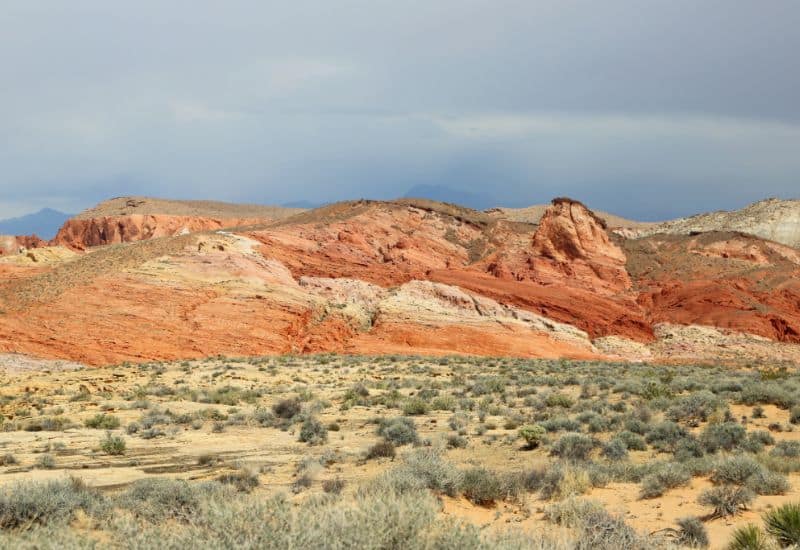
As the trail begins, visitors are treated to breathtaking views of the surrounding valley, with its towering red rock formations and sweeping desert vistas. But the real highlight of the Rainbow Vista trail is the stunning array of colors on display.
As you hike along the trail, you’ll be surrounded by a kaleidoscope of colors, from bright reds and oranges to soft pinks, purples, and blues. The rocks themselves are a geological wonder, with intricate layers of sandstone and other sedimentary rock formations.
One of the most striking features of the Rainbow Vista trail is the eponymous Rainbow Vista itself. This overlook offers stunning views of the surrounding valley and is one of the most photographed spots in the park.
The trail itself is well-maintained and relatively easy, with only a few inclines and rocky patches to navigate. Along the way, hikers will also have the opportunity to spot a variety of desert wildlife, including lizards, snakes, and birds of prey.
Whether you’re a seasoned hiker or just looking for a leisurely stroll through one of Nevada’s most stunning natural wonders, the Rainbow Vista trail is a must-do. So grab your camera and come experience the breathtaking beauty of the Valley of Fire State Park’s Rainbow Vista.
Atlatl Rock
One of the most spectacular hikes in the park is the Atlatl Rock Hike, which will take you through a landscape of towering rock formations, ancient petroglyphs, and sweeping vistas that will take your breath away.
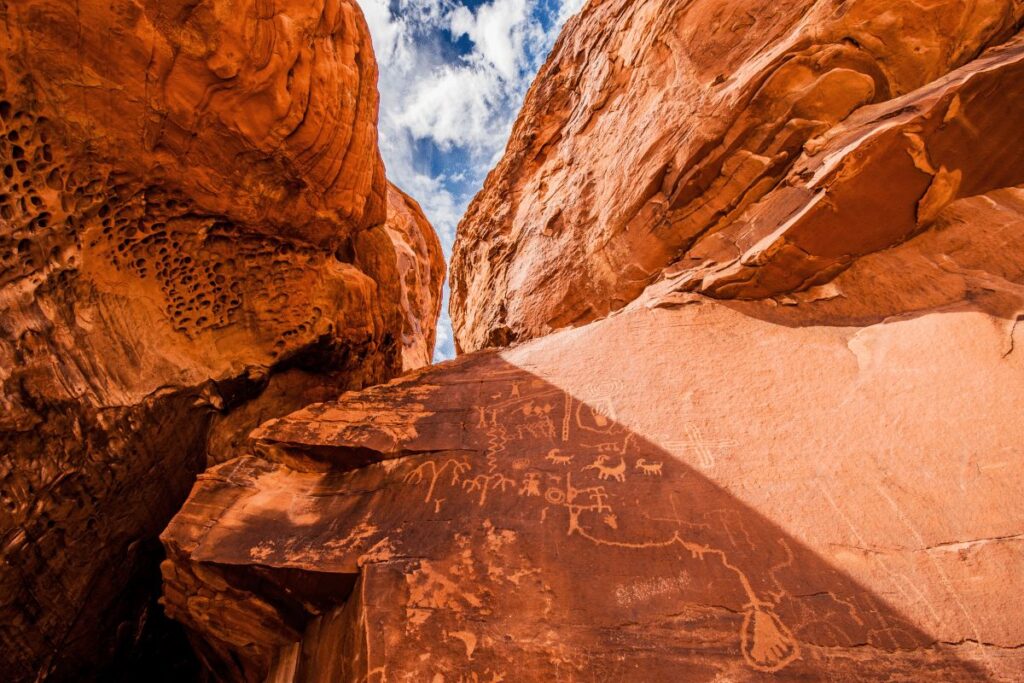
The Atlatl Rock Hike is a 0.6-mile trail that starts at the Atlatl Rock parking area, located in the heart of the park. The trail is easy to follow, with signs and markers pointing the way. As you start out on the trail, you’ll be surrounded by towering red rock formations that rise up from the desert floor. The rock formations are incredibly diverse, ranging from jagged spires to smooth, curving walls that seem to glow in the sun.
One of the highlights of the hike is the Atlatl Rock itself, a towering formation that rises up over 40 feet high. The rock is named after the atlatl, a primitive weapon used by Native Americans to hurl spears at their prey. The rock is covered in ancient petroglyphs, etched into the soft sandstone by the Ancestral Puebloans who lived in the area over a thousand years ago. The petroglyphs are incredibly detailed and intricate, depicting animals, people, and abstract patterns that still hold great significance for modern-day Native Americans.
As you continue on the trail, you’ll pass by other stunning rock formations, including Arch Rock, a massive arch that frames the desert landscape in the distance. You’ll also pass by several other petroglyph sites, each one offering a glimpse into the rich history and culture of the area.
You’ll arrive at the top of the trail, where you’ll be rewarded with sweeping views of the Valley of Fire. From here, you can see for miles in every direction, taking in the stunning desert landscape that surrounds you. It’s a moment of pure awe and wonder, and one that will stay with you long after you leave the park.
The Atlatl Rock Hike is a must-see for anyone visiting the Valley of Fire State Park. It’s a short, easy hike that offers an incredible glimpse into the natural and cultural history of the area. So grab your hiking boots, pack some water and snacks, and get ready for an adventure that you’ll never forget.
Beehives
One of the most fascinating features of this stunning park are the Beehives, a group of unique rock formations that have been shaped over millions of years by wind and water. These formations are a must-see for anyone visiting the park, and offer a glimpse into the incredible natural processes that have shaped the landscape of the American West.
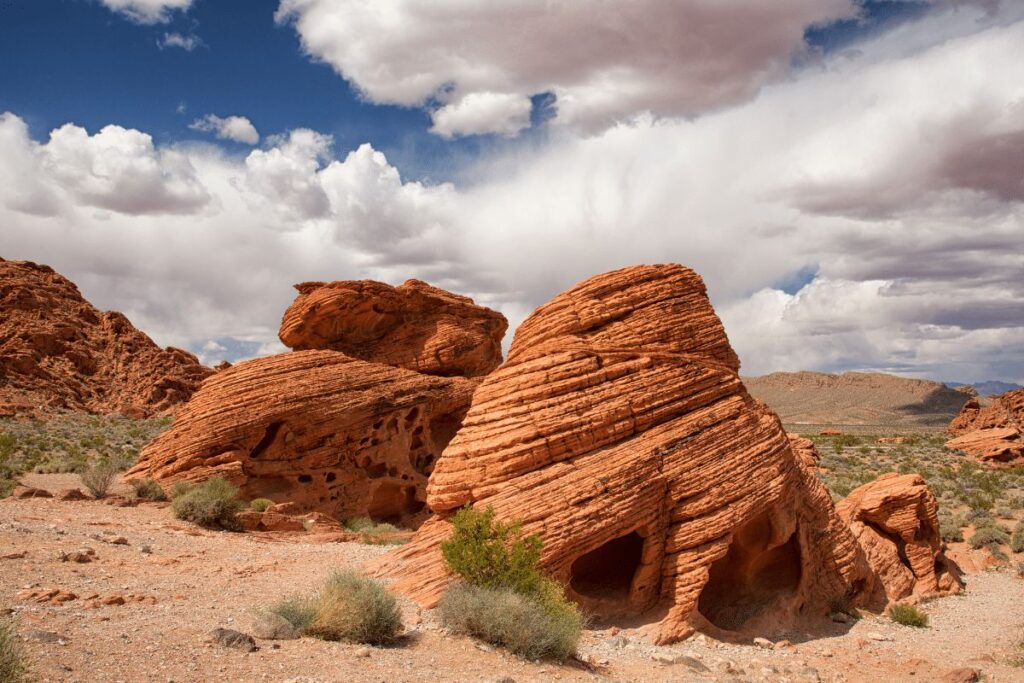
The Beehives are located in the southern part of the park, just a short drive from the visitor center. As you approach the formations, you’ll see that they resemble giant beehives, with layers of red and white sandstone stacked on top of one another in a cone-like shape. The colors of the rocks are truly spectacular, ranging from deep rust to bright white, and create a stunning contrast against the blue sky.
One of the best ways to experience the Beehives is to hike the Beehives Loop Trail, a 0.8-mile trail that takes you around the formations and offers incredible views of the surrounding landscape. As you hike, you’ll pass by towering walls of sandstone, unique rock formations, and even more ancient petroglyphs left behind by the Native Americans who once called this area home.
The Beehives themselves are incredibly photogenic and make for the perfect backdrop for some amazing selfies and Instagram-worthy shots. The formations look especially stunning at sunset when the rocks take on a golden glow that seems to radiate warmth and beauty.
If you’re feeling adventurous, you can climb to the Beehives’ top for an even better view of the park. The climb is relatively easy, but does require some scrambling over rocks and boulders. From the top, you’ll be rewarded with a 360-degree view of the park, including sweeping vistas of the surrounding desert landscape.
In conclusion, the Beehives at the Valley of Fire State Park are a must-see for anyone visiting the American Southwest. The unique rock formations, stunning colors, and incredible natural processes that have shaped them make for a truly unforgettable experience. So pack your camera and your sense of adventure, and get ready to explore one of the most fascinating landscapes in the world.
White Domes
The White Domes are a group of white sandstone formations that have been sculpted by wind and water over millions of years. The White Domes Trail is a popular hike in the park, and offers an incredible opportunity to explore this otherworldly landscape up close.

The White Domes Trail is a 1.1-mile loop trail that begins at the White Domes parking area, located in the southeastern part of the park. The trail is rated as moderate, and offers a variety of terrain and scenery that will keep you engaged and fascinated throughout your hike.
As you begin the hike, you’ll be surrounded by towering red rock formations, with the White Domes visible in the distance. The trail winds its way through a narrow canyon, offering stunning views of the colorful rock formations on either side. Along the way, you’ll also pass by ancient petroglyphs left behind by the Native Americans who once called this area home.
As you emerge from the canyon, you’ll be greeted by the stunning sight of the White Domes themselves. These towering formations are made of white sandstone, which has been eroded into a variety of shapes and patterns over millions of years. The contrast between the white sandstone and the red rocks around it is truly breathtaking, and makes for some incredible photo opportunities.
One of the highlights of the hike is the slot canyon, a narrow passage that winds its way through the rocks. The slot canyon is relatively short, but offers a thrilling and unforgettable experience as you navigate through its twists and turns. Be sure to bring a flashlight or headlamp, as the canyon can be quite dark in places.
As you make your way back to the trailhead, you’ll pass by even more stunning rock formations, including a natural arch that frames the desert landscape in the distance. It’s a fitting end to an incredible hike, and one that will leave you with memories to last a lifetime.
In conclusion, the White Domes Trail is a must-do hike for anyone visiting the Valley of Fire State Park. The stunning scenery, unique rock formations, and ancient history of the area make for an unforgettable experience that you won’t want to miss. So lace up your hiking boots, pack some water and snacks, and get ready for an adventure you’ll never forget.
Elephant Rock
Elephant Rock is a massive rock formation that has been shaped over millions of years by wind and water. The Elephant Rock Loop Trail is a popular hike in the park, and offers an incredible opportunity to explore this otherworldly landscape up close.
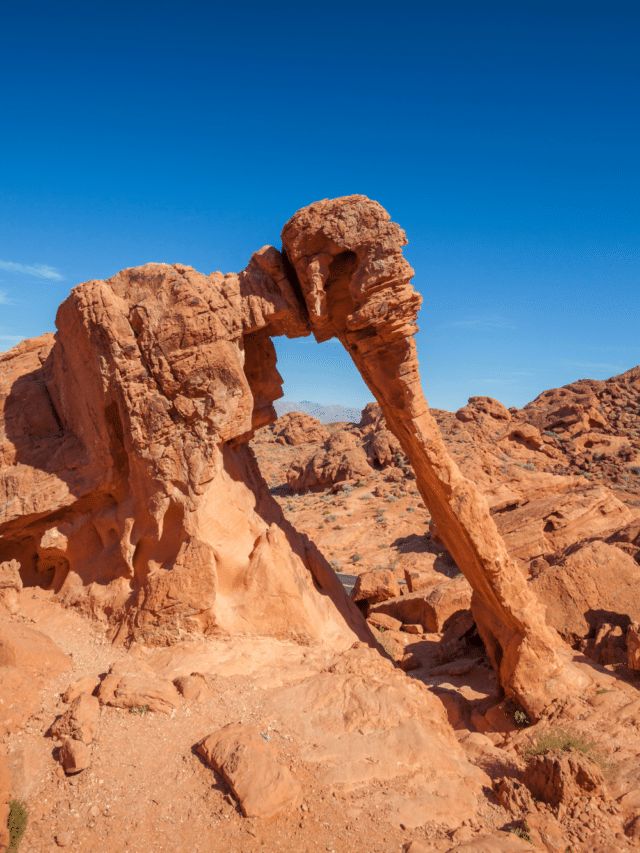
The Elephant Rock Loop Trail is a 1.3-mile loop trail that begins at the Atlatl Rock parking area, located in the northern part of the park. The trail is rated as easy to moderate, and offers a variety of terrain and scenery that will keep you engaged and fascinated throughout your hike.
As you begin the hike, you’ll be surrounded by towering red rock formations, with Elephant Rock visible in the distance. The trail winds its way through a desert landscape, offering stunning views of the colorful rock formations on either side. Along the way, you’ll also pass by ancient petroglyphs left behind by the Native Americans who once called this area home.
As you approach Elephant Rock, you’ll be amazed by its massive size and incredible shape. The rock formation truly looks like an elephant, complete with a long trunk, huge ears, and massive legs. The contrast between the light-colored rock of the elephant and the deep red rock around it is truly breathtaking and makes for some incredible photo opportunities.
One of the highlights of the hike is the scramble up to the top of Elephant Rock. The climb is relatively easy but does require some scrambling over rocks and boulders. From the top, you’ll be rewarded with a 360-degree view of the park, including sweeping vistas of the surrounding desert landscape. It’s a fitting end to an incredible hike, and one that will leave you with memories to last a lifetime.
In conclusion, the Elephant Rock Loop Trail is a must-do hike for anyone visiting the Valley of Fire State Park. The stunning scenery, unique rock formations, and ancient history of the area make for an unforgettable experience that you won’t want to miss. So lace up your hiking boots, pack some water and snacks, and get ready for an adventure you’ll never forget.
Fire Canyon
The Valley of Fire State Park is a true natural wonderland of stunning rock formations, ancient petroglyphs, and sweeping vistas. One of the most unique and captivating features of the park is Fire Canyon, a narrow and winding canyon that offers a truly unforgettable hiking experience.
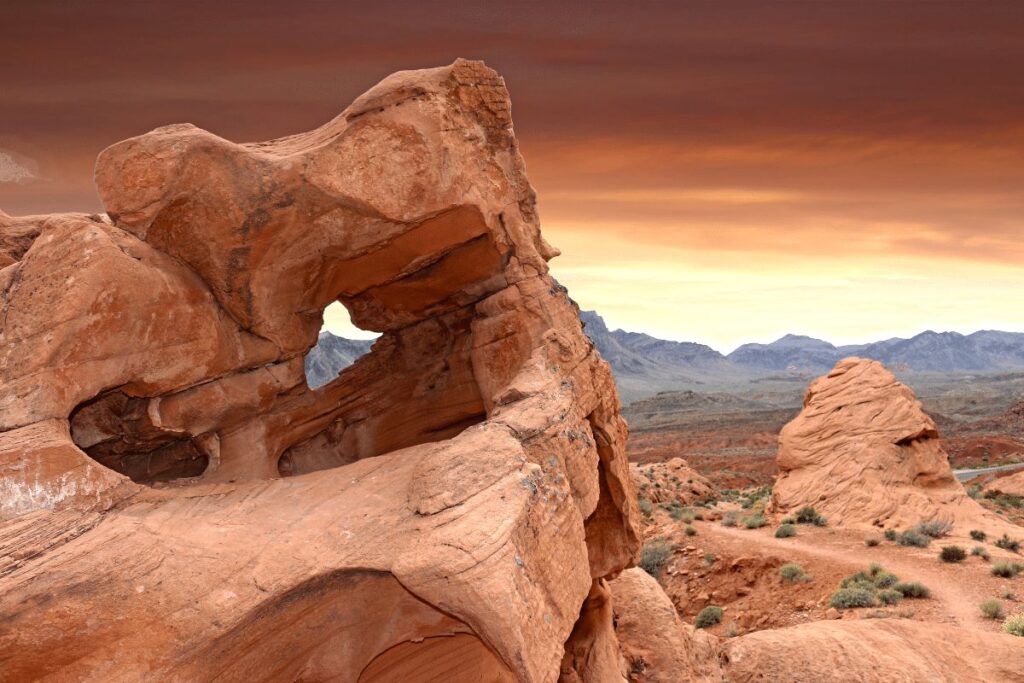
The Fire Canyon Trail is a 2.2-mile out-and-back trail that begins at the Fire Canyon parking area, located in the southeastern part of the park. The trail is rated as moderate, and offers a variety of terrain and scenery that will keep you engaged and fascinated throughout your hike.
As you begin the hike, you’ll be surrounded by towering red rock formations, with Fire Canyon visible in the distance. The trail winds its way through a desert landscape, offering stunning views of the colorful rock formations on either side. Along the way, you’ll also pass by ancient petroglyphs left behind by the Native Americans who once called this area home.
As you enter Fire Canyon, you’ll be amazed by the narrow and winding nature of the canyon. The towering red rock walls rise up on either side of you, with twists and turns that make for an exciting and immersive hiking experience. The contrast between the light-colored rock and the deep red rock around it is truly breathtaking, and makes for some incredible photo opportunities.
One of the highlights of the hike is the climb up to the top of Fire Canyon. The climb is relatively steep, but does require some scrambling over rocks and boulders. From the top, you’ll be rewarded with a stunning view of the surrounding desert landscape, including sweeping vistas of the surrounding rock formations and the distant mountains.
As you make your way back down the canyon, you’ll be treated to even more stunning scenery, including towering rock formations and sweeping vistas of the desert landscape. It’s a fitting end to an incredible hike, and one that will leave you with memories to last a lifetime.
In conclusion, the Fire Canyon Trail is a must-do hike for anyone visiting the Valley of Fire State Park. The stunning scenery, unique rock formations, and ancient history of the area make for an unforgettable experience that you won’t want to miss. So lace up your hiking boots, pack some water and snacks, and get ready for an adventure you’ll never forget.
Mouse’s Tank
Mouse’s Tank is a narrow canyon that is home to some of the most well-preserved petroglyphs in the region.
The Mouse’s Tank Trail is a 0.7-mile out-and-back trail that begins at the Mouse’s Tank parking area, located in the northern part of the park. The trail is rated as easy, and offers a variety of terrain and scenery that will keep you engaged and fascinated throughout your hike.
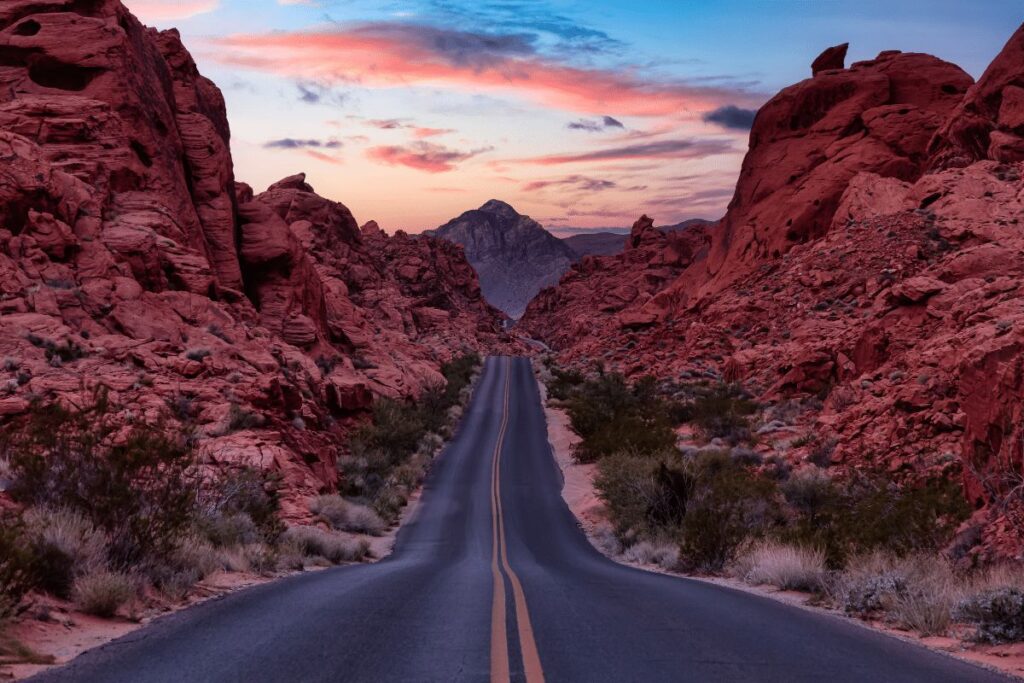
As you begin the hike, you’ll be surrounded by towering red rock formations, with Mouse’s Tank visible in the distance. The trail winds its way through a desert landscape, offering stunning views of the colorful rock formations on either side. Along the way, you’ll also pass by ancient petroglyphs left behind by the Native Americans who once called this area home.
As you enter Mouse’s Tank, you’ll be amazed by the narrow and winding nature of the canyon. The towering red rock walls rise up on either side of you, with twists and turns that make for an exciting and immersive hiking experience. The canyon also features a natural basin that collects rainwater, which is where it gets its name “Mouse’s Tank.” According to local legend, a Paiute Indian named Mouse used the basin to hide out from the law in the 1890s.
As you continue along the trail, keep an eye out for the petroglyphs that adorn the canyon walls. These ancient rock carvings depict a variety of animals, people, and abstract designs, and are thought to be thousands of years old. Some of the most well-preserved petroglyphs in the canyon can be found near the end of the trail, making this a must-see destination for history and nature enthusiasts alike.
In conclusion, the Mouse’s Tank Trail is a must-do hike for anyone visiting the Valley of Fire State Park. The stunning scenery, unique rock formations, and ancient history of the area make for an unforgettable experience that you won’t want to miss. So lace up your hiking boots, pack some water and snacks, and get ready for an adventure you’ll never forget.
Pink Canyon
This stunning slot canyon, located in the northern part of the park, is known for its vibrant pink and red sandstone walls and otherworldly rock formations.
The hike to Pink Canyon is not well-marked and can be a bit challenging to navigate, so it’s important to come prepared with a map or GPS. The trailhead is located near the Fire Wave, another popular hiking destination in the park, and the hike to the canyon is approximately 2.5 miles roundtrip.

As you make your way towards Pink Canyon, you’ll be treated to sweeping views of the surrounding desert landscape, with towering red rock formations and distant mountains providing a dramatic backdrop. The trail itself is rocky and uneven in places, so be sure to wear sturdy hiking shoes and bring plenty of water.
As you approach Pink Canyon, you’ll notice the walls of the canyon begin to narrow and the sandstone take on a pinkish hue. The canyon walls rise up on either side of you, creating a sense of being enclosed in a secret world. The formations within the canyon are truly otherworldly, with twisted and contorted shapes that seem to defy gravity.
The highlight of the Pink Canyon hike is the natural arch located towards the end of the canyon. The arch is framed by the stunning pink and red sandstone walls of the canyon, creating a truly Instagram-worthy photo opportunity.
The Pink Canyon hike is a unique and rewarding experience for adventurous hikers looking to explore the lesser-known corners of the Valley of Fire State Park. The stunning natural beauty of the area is truly a sight to behold, and the challenge of finding the canyon only adds to the sense of adventure and excitement. So if you’re up for a challenge and ready to explore some of the most beautiful landscapes in Nevada, be sure to add Pink Canyon to your list of must-see destinations.
Arch Rock
For a short and easy hike with a big payoff, head to Arch Rock in the Valley of Fire State Park. This 0.6-mile out-and-back trail is perfect for hikers of all levels, and offers stunning views of the park’s iconic red rock formations.
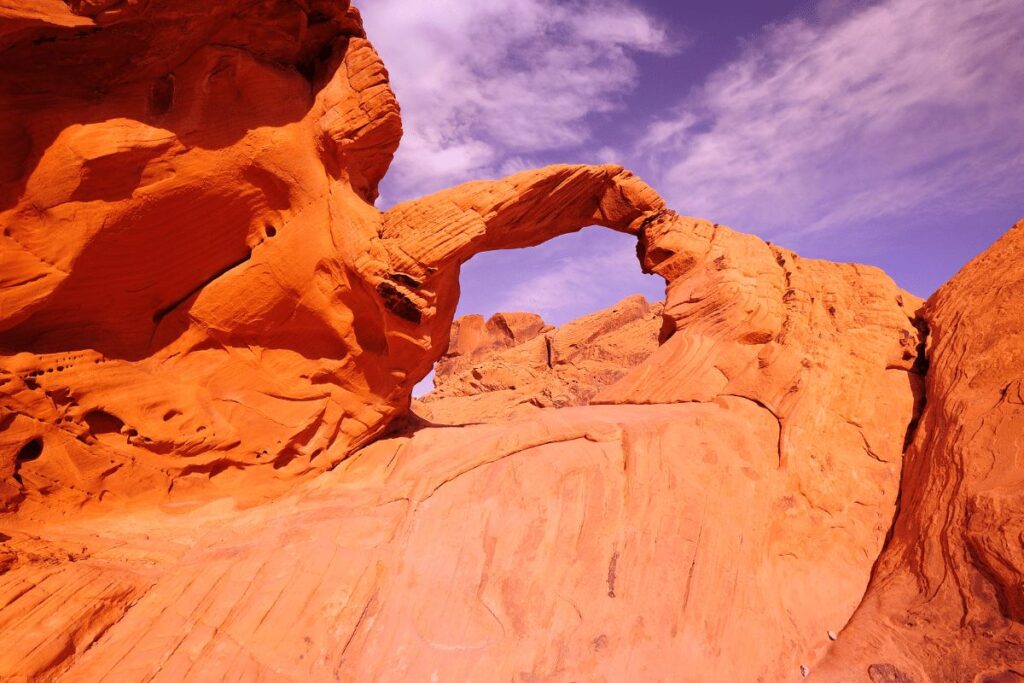
The trailhead for Arch Rock is located near the park’s East Entrance, and can be easily accessed by car or on foot. From there, the trail winds through a desert landscape of twisted Joshua trees and rugged rock formations, before leading hikers to the impressive Arch Rock formation.
The arch itself is a natural wonder, with a massive sandstone formation creating a natural archway that spans approximately 20 feet. The arch is a popular spot for photos, and makes for an excellent backdrop for group shots or solo selfies.
Beyond the arch, the trail continues on for a short distance before ending at a rocky overlook with sweeping views of the surrounding desert landscape. From here, you can see for miles in every direction, with the towering red rocks of the Valley of Fire State Park rising up in the distance.
While the Arch Rock trail is short and relatively easy, it’s important to come prepared with sturdy hiking shoes, sunscreen, and plenty of water, as the desert can be unforgiving. Be sure to also keep an eye out for wildlife, as the park is home to a variety of animals including bighorn sheep, rattlesnakes, and coyotes.
The Arch Rock trail is a must-see destination for anyone visiting the Valley of Fire State Park. Its stunning natural beauty and easy accessibility make it a popular spot for families, photographers, and hikers alike. So grab your camera, lace up your hiking boots, and head out to experience one of the most beautiful destinations in Nevada.
Petroglyph Canyon
One of the most fascinating hikes in the Valley of Fire State Park is the Petroglyph Canyon trail. This 0.5-mile trail takes visitors through a stunning canyon filled with ancient petroglyphs etched into the rocks.
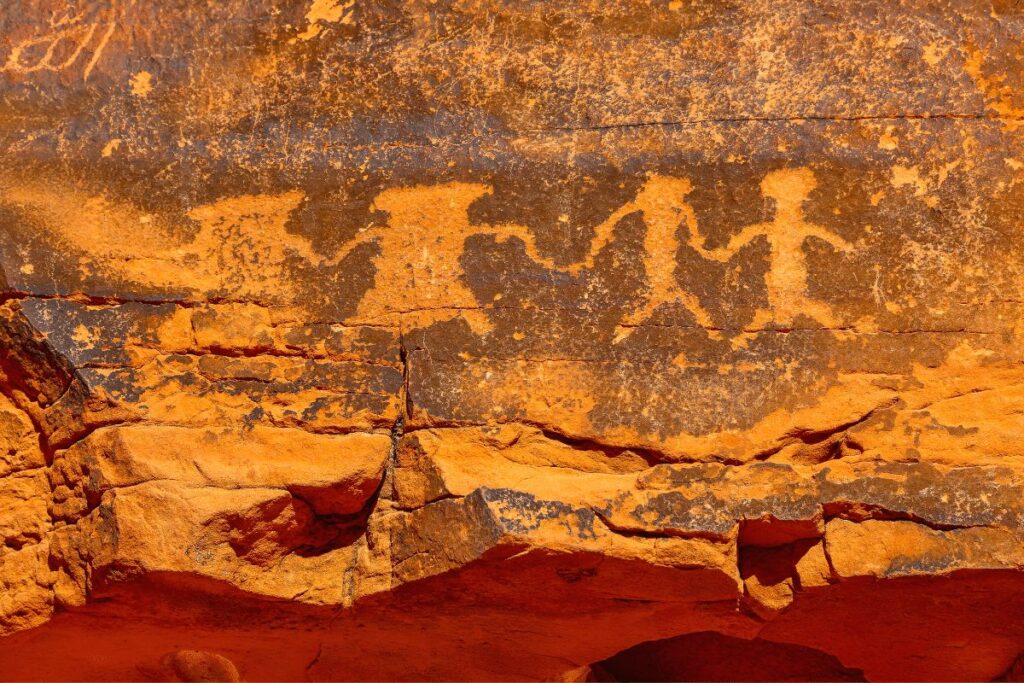
The petroglyphs are believed to have been created by Native American tribes that lived in the area over 2,000 years ago. The images include depictions of animals, people, and abstract shapes, and offer a fascinating glimpse into the lives and beliefs of these ancient people.
The trail itself is relatively easy, but does require some scrambling over rocks and boulders. Along the way, hikers will be treated to stunning views of the park’s towering red rock formations, as well as the unique desert flora and fauna that call the area home.
One of the highlights of the Petroglyph Canyon trail is the sheer variety of petroglyphs that can be found along the way. From simple shapes and designs to more complex scenes of hunting and religious ceremonies, the petroglyphs offer a fascinating window into the past.
Despite their age, the petroglyphs are remarkably well-preserved, and visitors are encouraged to view them with respect and awe. The trail is also an important reminder of the rich cultural history of the Valley of Fire State Park, and a testament to the enduring legacy of the Native American tribes that once called the area home.
Whether you’re a history buff, a nature lover, or simply looking for a unique and unforgettable experience, the Petroglyph Canyon trail is not to be missed. So grab your hiking boots and come explore one of Nevada’s most fascinating archaeological treasures.
Wildlife in the Valley of Fire
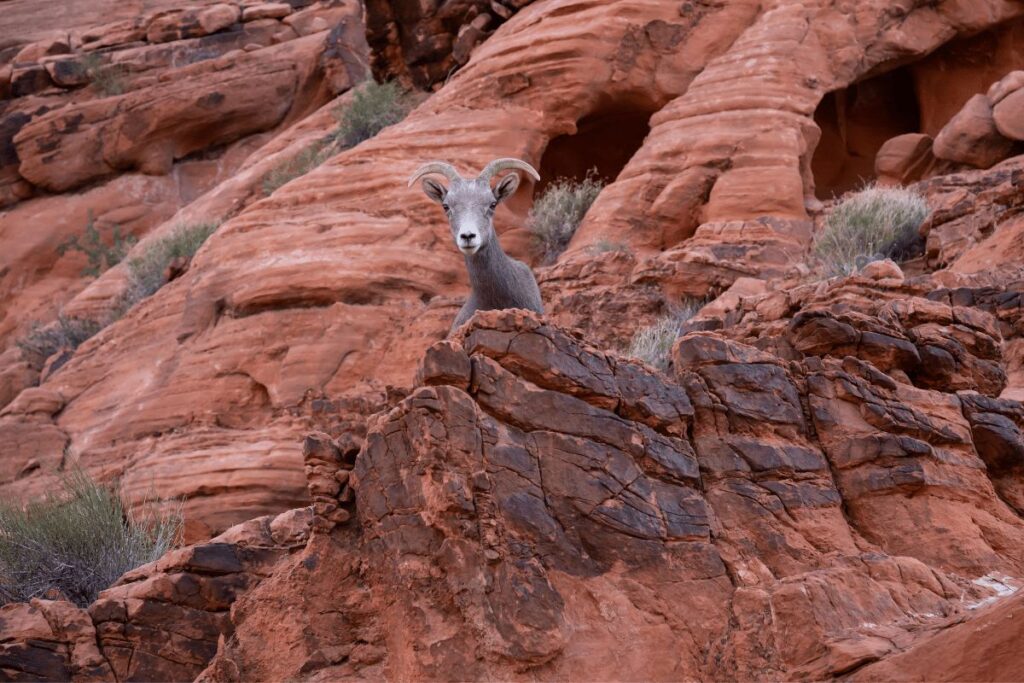
The Valley of Fire is home to a wide variety of wildlife, including bighorn sheep, bobcats, coyotes, desert tortoises, and many more. The best time to see wildlife in the park is early morning or evening.
Also Read: Valley Of Fire State Park : 11 Animals We Saw While Hiking
Also Read: Exploring The Valley Of Fire: 9 Unique And Unforgettable Activities To Do (Tips And Tours Included)
Also Read: 9 Best Viator Tours In The Valley Of Fire State Park Our Team Went On!
Trails we Hiked to See These Iconic Vistas in the Valley of Fire
Valley of Fire State Park is home to some of the most stunning hiking trails in Nevada. From easy walks to strenuous hikes, the park offers something for every level of hiker. Here are some of the top trails we explored:
Atlatl Rock Trail
The Atlatl Rock Trail is a short but fascinating hike that takes visitors up a rock face to view Native American petroglyphs. The trail is just 0.1 miles long, but it involves climbing stairs up the rock face. Once at the top, hikers can explore the collection of petroglyphs depicting ancient life in the area.
Petrified Logs Trail
The Petrified Logs Trail is a 0.3-mile hike that leads visitors to petrified logs on the desert floor. The trail passes panels explaining how wood is petrified and offers a close-up look at these ancient logs.
Also Read: 20+ Guided Things To Do In The Valley Of Fire State Park!
Balancing Rock Trail
The Balancing Rock Trail is a 0.25-mile hike that begins next to the Valley of Fire State Park Visitor Center. The trail leads visitors to a rock formation that appears to defy gravity, standing with a bit of magic.
Elephant Rock Hike
The Elephant Rock Hike is a 0.3-mile hike at the east entrance of Valley of Fire State Park. The trail leads visitors to a sandstone formation resembling an elephant with a unique natural arch for a trunk.
Mouse’s Tank Trail Petroglyph Canyon
The Mouse’s Tank Trail Petroglyph Canyon is a 0.75-mile hike that travels down a sandy path lined with petroglyphs to a natural basin formed in the sandstone. The basin, known as Mouse’s Tank, is a popular spot for birdwatching.
Rainbow Vista Trail
The Rainbow Vista Trail is a hike of up to 1.5 miles that goes up a sandstone mini-summit with tremendous 360-degree views over multi-colored landscapes. The trail continues on to Fire Canyon Overlook, offering stunning views of the surrounding rock formations.
Fire Wave Hike
The Fire Wave Hike is a 1.5-mile hike that reaches a sensational striped creation where a slickrock depression is painted in waves of orange and beige. The trail offers stunning views of the surrounding rock formations and is a popular spot for photography.
White Domes Trail
The White Domes Trail is a 1.1-mile loop that explores colorful, intricate rock formations and passes an old film set. The trail also slips through a narrow slot canyon, making it a favorite among visitors.
Conclusion
From petroglyphs and natural archways to unique rock formations and vast landscapes, the Valley of Fire State Park offers a wealth of wonders for adventure seekers. For those looking to explore what Nevada has to offer beyond Las Vegas, the Valley of Fire is a must-visit destination with countless activities and attractions that can be enjoyed by all ages.
Whether you are planning an extended family vacation or just want a quick weekend trip away from it all, take some time to discover this hidden gem in Nevada’s backyard!
The trails we explored offer stunning views and a unique look at the natural beauty of Valley of Fire State Park. Visitors should be prepared for hot, dry weather and bring plenty of water and sunscreen.

